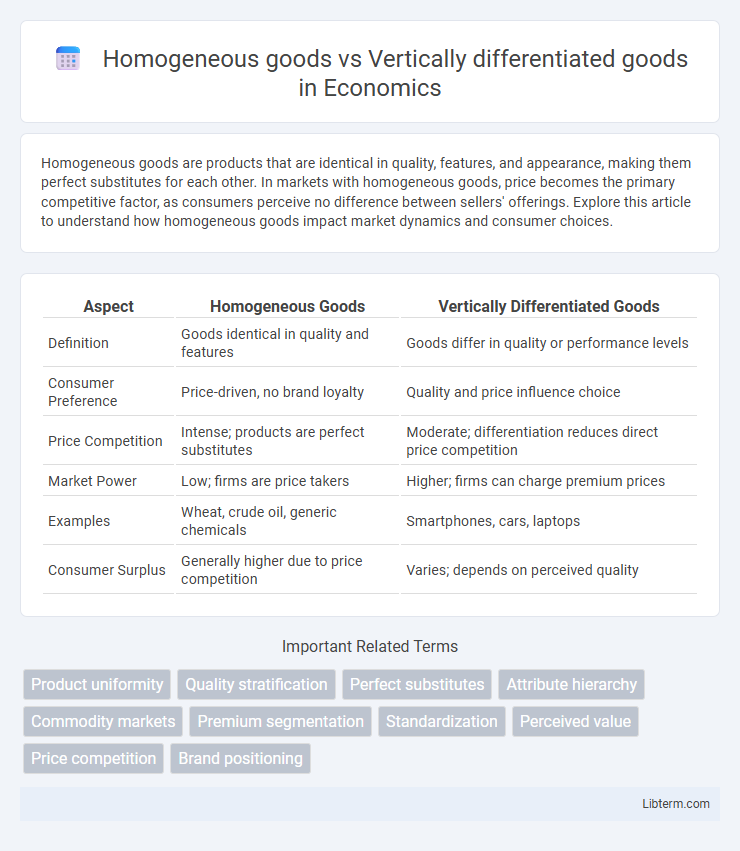Homogeneous goods are products that are identical in quality, features, and appearance, making them perfect substitutes for each other. In markets with homogeneous goods, price becomes the primary competitive factor, as consumers perceive no difference between sellers' offerings. Explore this article to understand how homogeneous goods impact market dynamics and consumer choices.
Table of Comparison
| Aspect | Homogeneous Goods | Vertically Differentiated Goods |
|---|---|---|
| Definition | Goods identical in quality and features | Goods differ in quality or performance levels |
| Consumer Preference | Price-driven, no brand loyalty | Quality and price influence choice |
| Price Competition | Intense; products are perfect substitutes | Moderate; differentiation reduces direct price competition |
| Market Power | Low; firms are price takers | Higher; firms can charge premium prices |
| Examples | Wheat, crude oil, generic chemicals | Smartphones, cars, laptops |
| Consumer Surplus | Generally higher due to price competition | Varies; depends on perceived quality |
Introduction to Product Differentiation
Product differentiation distinguishes homogeneous goods, which are identical and interchangeable, from vertically differentiated goods that vary based on quality levels perceived by consumers. Homogeneous goods compete primarily on price since products offer no intrinsic differences, while vertical differentiation allows firms to target different market segments by offering varying quality and price points. Understanding these distinctions aids in analyzing market structures and consumer choice behavior.
Defining Homogeneous Goods
Homogeneous goods are products that are identical in quality, features, and performance, making them perfectly substitutable regardless of the seller. These goods lack distinguishing characteristics, leading to competition primarily based on price. In contrast, vertically differentiated goods vary in quality or attributes, allowing consumers to rank products and make choices based on perceived superiority.
Understanding Vertically Differentiated Goods
Vertically differentiated goods are products that vary in quality or features, allowing consumers to rank them from best to worst based on objective criteria such as performance or durability. Unlike homogeneous goods, which are perfect substitutes differing only in price, vertically differentiated goods cater to different consumer preferences and willingness to pay for superior quality. This differentiation enables firms to target distinct market segments by offering varying quality levels at corresponding price points.
Key Characteristics of Homogeneous Goods
Homogeneous goods are characterized by their identical nature, making products from different producers perfect substitutes with no variation in quality or features. Prices are the primary differentiator in markets for homogeneous goods, leading to high price competition and minimal brand loyalty. These goods typically include raw materials like crude oil, wheat, and metals, where uniformity simplifies consumer choice and pricing strategies.
Features of Vertically Differentiated Goods
Vertically differentiated goods vary in quality, performance, and price, allowing consumers to rank products based on objective criteria such as durability, functionality, or brand reputation. These goods offer a clear hierarchy where higher quality corresponds to higher value and cost, catering to different consumer preferences and willingness to pay. Unlike homogeneous goods, which are identical and compete mainly on price, vertically differentiated products emphasize feature differences that drive market segmentation and consumer choice.
Market Structure and Competition Implications
Homogeneous goods lead to perfect competition where firms are price takers, resulting in zero economic profit in the long run due to identical products and high substitutability. Vertically differentiated goods create a market with product quality tiers, allowing firms to segment the market and exert some pricing power, fostering monopolistic competition and higher profit margins. Market structure shifts from price-driven competition in homogeneous goods to quality and branding-driven competition in vertically differentiated goods, influencing entry barriers and consumer choice dynamics.
Consumer Choice: Homogeneous vs Vertically Differentiated Goods
Consumer choice for homogeneous goods is primarily driven by price since products are identical and substitutable, leading shoppers to prefer the lowest-cost option. In markets with vertically differentiated goods, consumers evaluate quality variations alongside price, opting for higher-priced premium options if perceived quality justifies the expense. This differentiation influences willingness to pay and creates a spectrum of consumer preferences based on budget and quality sensitivity.
Pricing Strategies for Both Product Types
Pricing strategies for homogeneous goods often emphasize competitive pricing, aiming to match or undercut rivals due to the lack of product differentiation and high price sensitivity among consumers. Vertically differentiated goods, offering varying quality levels, enable firms to employ price discrimination by segmenting the market based on willingness to pay, often using premium pricing for higher quality tiers and penetration pricing for lower quality options. Understanding consumer demand elasticity and perceived value plays a crucial role in optimizing pricing strategies for both homogeneous and vertically differentiated products.
Real-World Examples and Case Studies
Homogeneous goods, such as crude oil and wheat, are standardized products with little to no differentiation, allowing firms like ExxonMobil to compete primarily on price and availability in global markets. Vertically differentiated goods, found in industries like automotive manufacturing with brands such as Tesla and Toyota, vary in quality and features, enabling companies to target different consumer segments and command premium prices. Case studies from the smartphone industry illustrate how Apple's high-end iPhones contrast with budget models from Samsung, demonstrating vertical differentiation through technology and user experience enhancements.
Conclusion: Impacts on Businesses and Markets
Homogeneous goods create intense price competition among businesses, leading to lower profit margins and increased market efficiency for consumers. Vertically differentiated goods allow firms to target niche market segments with varying quality levels, enabling higher profit potential and brand loyalty. Market dynamics shift as homogeneous goods promote standardization, while vertical differentiation drives innovation and diversity in product offerings.
Homogeneous goods Infographic

 libterm.com
libterm.com